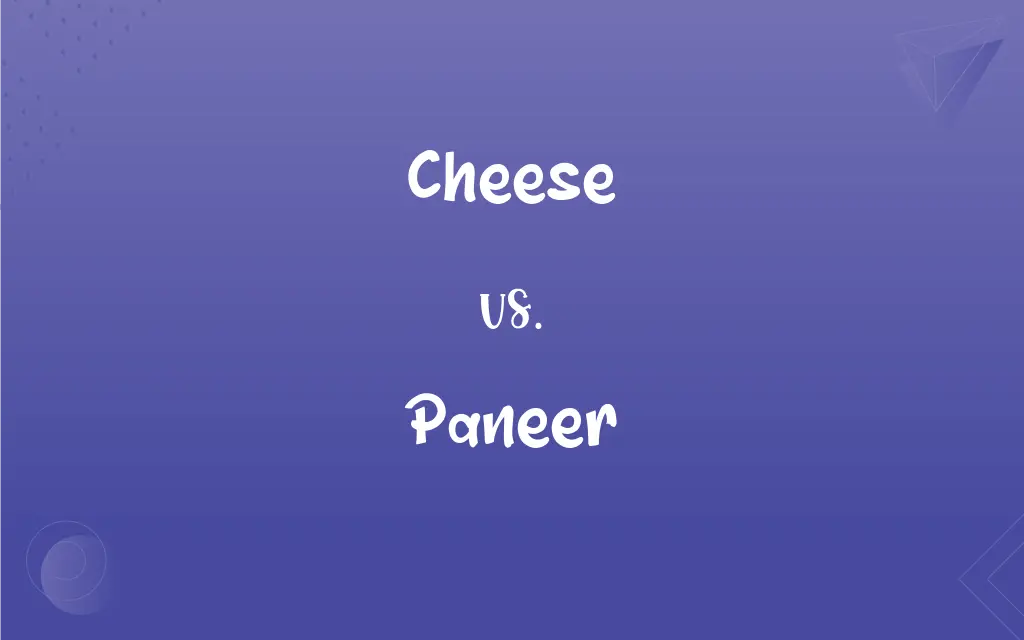Cheese vs. Paneer: What's the Difference?
Edited by Janet White || By Harlon Moss || Updated on October 25, 2023
Cheese is a dairy product derived from milk and produced in a wide range of flavors and textures, while paneer is a fresh, unsalted cheese popular in Indian cuisine.

Key Differences
Cheese is a broad term that encompasses a variety of dairy products made from the curdling of milk, often aged to develop flavor and texture. Paneer, on the other hand, is a specific type of cheese prevalent in Indian cooking, known for its fresh and soft consistency. The process of making cheese involves adding rennet or bacterial cultures to milk, leading to curd separation, and then aging the product for flavor development in many cases. In contrast, paneer is made by curdling milk using food acids like lemon juice or vinegar, and it isn't aged or fermented.
Both cheese and paneer offer unique culinary experiences. Cheese, due to its diverse range, can be soft like brie, hard like parmesan, or crumbly like feta. Paneer possesses a distinct mild flavor and retains its shape even when cooked, making it a staple in dishes like 'paneer tikka' or 'palak paneer'. Cheese, being a global product, has found its way into numerous cuisines, from Italian pizzas to French quiches. Paneer, though rooted in South Asian cuisine, has started gaining popularity worldwide as a vegetarian protein source.
Another distinguishing feature is the presence or absence of salt. While many cheeses have salt added for flavor and preservation, paneer is traditionally unsalted. This characteristic allows paneer to be a versatile ingredient, fitting into both savory and sweet dishes. The nutritional profiles of cheese and paneer also differ. Cheese, depending on its type, can be high in fats and sodium. Paneer, being fresh, generally has a simpler nutritional profile with protein and fat from milk.
In essence, while both cheese and paneer originate from milk, their preparation methods, taste profiles, and applications in cooking are distinct, making each unique in the dairy world.
Comparison Chart
Origin
Global
Indian
ADVERTISEMENT
Making Process
Often uses rennet/bacterial cultures, can be aged.
Uses food acids, not aged.
Texture and Flavor
Varies widely (soft, hard, crumbly); can be salty and strong.
Soft, crumbly; mild flavor.
Culinary Uses
Diverse, used in many cuisines.
Common in South Asian dishes.
Salt Content
Often contains added salt.
Traditionally unsalted.
Cheese and Paneer Definitions
Cheese
Cheese is made using various methods and ingredients.
Blue cheese is distinctive due to the mold veins running through it.
ADVERTISEMENT
Paneer
Paneer is a fresh cheese used in Indian cuisine.
Paneer butter masala is a rich and creamy dish.
Cheese
Cheese can be aged to develop different flavors and textures.
Aged cheeses like cheddar have a stronger taste than fresh ones.
Paneer
Paneer retains its shape during cooking.
She added cubes of paneer to the spicy gravy.
Cheese
Cheese is consumed worldwide in diverse forms.
In France, cheese is often enjoyed with wine and bread.
Paneer
Paneer is made by curdling milk with food acids.
Adding lemon juice to boiling milk will yield paneer.
Cheese
Cheese can be made from the milk of various animals.
Goat cheese has a tangy flavor distinct from cow milk cheese.
Paneer
Paneer is unsalted and has a mild taste.
Paneer can be used in both savory and sweet dishes.
Cheese
Cheese is a dairy product made by curdling milk.
She loves adding cheese to her sandwiches for extra flavor.
Paneer
Paneer is a rich source of vegetarian protein.
Many vegetarians consume paneer for its protein content.
Cheese
A solid food prepared from the pressed curd of milk, often seasoned and aged.
Paneer
A soft unsalted and unripened cheese made from milk that is simmered, curdled using lemon juice, vinegar, yogurt, or a similarly acidic substance, and then drained and pressed in cheesecloth.
Paneer
A soft, non-matured, Indian cheese.
The spinach was mixed with paneer to make a satisfying meal.
FAQs
Why doesn't paneer melt like other cheeses?
Paneer's protein structure, due to acid-set curdling, doesn't allow it to melt like aged cheeses.
Can I make paneer at home?
Yes, by curdling boiled milk with food acids like lemon juice, then draining the whey.
Is paneer a type of cheese?
Yes, paneer is a type of fresh cheese popular in Indian cuisine.
Why is paneer not aged like other cheeses?
Paneer is meant to be consumed fresh and isn't processed for aging.
Is paneer healthier than cheese?
Both have nutritional benefits, but paneer is often lower in sodium and fats than aged cheeses.
Is there lactose in cheese and paneer?
Both contain lactose, but some aged cheeses have lower amounts than paneer.
Is there a vegan version of paneer?
Tofu is often used as a vegan alternative to paneer.
Why is paneer so popular in Indian vegetarian dishes?
Paneer offers a substantial protein source for vegetarian diets and adapts well to various flavors.
Are there flavored versions of paneer?
Traditional paneer is plain, but some modern versions might include spices or herbs.
Can I use cheese in Indian dishes as a substitute for paneer?
While possible, it will alter the dish's flavor and texture.
Are cheese and paneer good sources of calcium?
Yes, both are dairy products and naturally rich in calcium.
How long can I store paneer and cheese?
While paneer should be consumed within a few days, some cheeses can be stored longer, depending on their type.
Is feta cheese similar to paneer?
Both are crumbly, but feta is saltier and tangier than paneer.
Why do some cheeses smell strong?
The aging process and specific bacterial cultures can give some cheeses a strong aroma.
Can I use cheese as a substitute for paneer in recipes?
While they are different, firm tofu or halloumi can be closer substitutes for paneer than other cheeses.
Can I use paneer in Italian dishes as a cheese substitute?
Paneer's mild flavor allows it to be versatile, but its texture and taste will differ from traditional Italian cheeses.
Can I eat paneer raw?
Yes, paneer can be consumed raw, cooked, or even grilled.
How do I know if my paneer or cheese has gone bad?
Both will develop an off smell, sour taste, and possibly mold when spoiled.
Can I use paneer in salads?
Absolutely, paneer can be added to salads, grilled, or even eaten raw.
Which cheese is closest in texture to paneer?
Firm tofu or halloumi cheese can resemble paneer's texture.
About Author
Written by
Harlon MossHarlon is a seasoned quality moderator and accomplished content writer for Difference Wiki. An alumnus of the prestigious University of California, he earned his degree in Computer Science. Leveraging his academic background, Harlon brings a meticulous and informed perspective to his work, ensuring content accuracy and excellence.
Edited by
Janet WhiteJanet White has been an esteemed writer and blogger for Difference Wiki. Holding a Master's degree in Science and Medical Journalism from the prestigious Boston University, she has consistently demonstrated her expertise and passion for her field. When she's not immersed in her work, Janet relishes her time exercising, delving into a good book, and cherishing moments with friends and family.































































